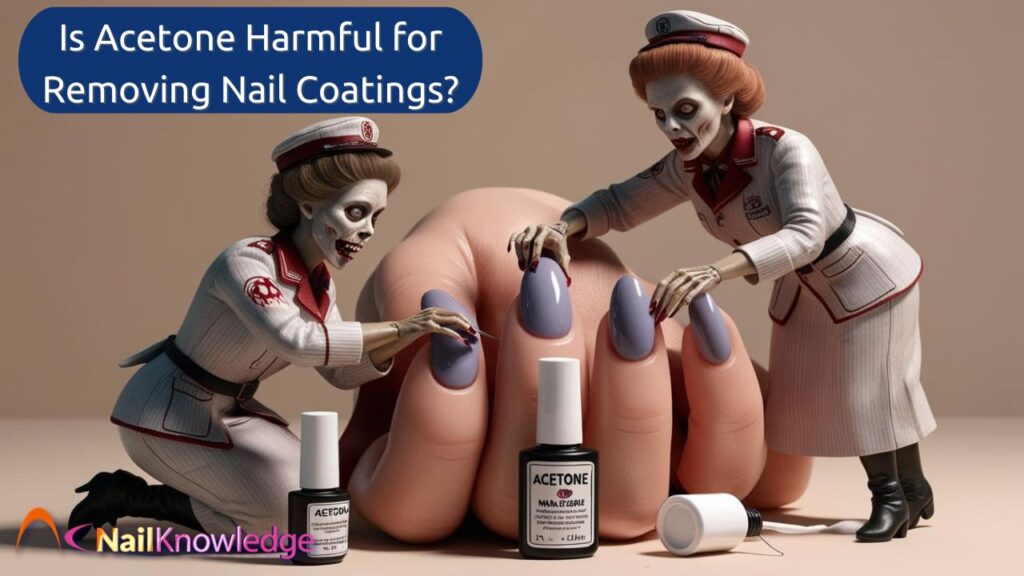Acetone is a ubiquitous presence in nail salons, often used to remove nail coating products with remarkable efficiency. But as we dip our fingertips into this potent solvent, it’s natural to wonder about its safety. Is acetone harmful for removing nail coatings? Let’s investigate the science and separate fact from fiction.
O poder de penetração da acetona
When it comes to acetone and skin penetration, it’s crucial to distinguish between “into” and “through”. Acetone doesn’t penetrate through the skin or placa ungueal in significant amounts, but it can enter into the upper layers. Picture it like a shallow puddle on a hot pavement – it might seep into the cracks, but it won’t reach the underlying soil.
The rapid evaporation of acetone is key to understanding its effects. As soon as it touches your skin, the warmth of your hand causes it to evaporate quickly. This swift exit strategy means that acetone doesn’t hang around long enough to cause lasting damage. However, it does leave a calling card – temporary dehydration of the surface layers of skin and nails.
Desidratação: Um efeito de superfície temporário
Imagine your skin as a sponge. When you douse it with acetone, it’s like squeezing that sponge dry – but only on the surface. The acetone binds with water in the upper layers, causing it to vaporize along with the solvent. This creates a temporary drying effect, much like how a cool breeze might make your lips feel chapped.
But fear not! This dehydration is fleeting. Just as a dry sponge quickly absorbs water when dunked, your skin and nails will rehydrate when exposed to moisture. It’s a bit like magic – now you see it, now you don’t!
Segurança em primeiro lugar: Acetona em salões de beleza
Is acetone harmful for removing nail coatings in the long run? The evidence suggests not. With a long history of safe use in salons, acetone has earned its stripes as one of the safest solvents available for nail care. It’s like the trusty old hammer in a toolbox – simple, effective, and reliable.
However, like any tool, acetone must be used correctly. It’s highly flammable, so keep it away from heat sources, sparks, or flames. Using acetone near a lit cigarette or candle would be like juggling fireballs, exciting, but potentially disastrous!
Aquecendo-se com a acetona (mas não muito!)
If you’ve ever considered warming acetone to boost its effectiveness, think again. Heating acetone is like revving a sports car engine – it makes it more volatile and potentially dangerous. The safest method is to gently warm it in a loosely capped plastic bottle submerged in warm water, no hotter than a cosy Jacuzzi (about 40°C or 104°F).
Remember, it’s the acetone vapours that are flammable, not the liquid itself. So, using acetone in a well-ventilated area is crucial. Think of it as giving the acetone room to breathe – and keeping your lungs happy too!
O veredicto: a acetona é prejudicial para a remoção de revestimentos de unhas?
In the grand scheme of things, acetone appears to be a safe choice for removing nail coatings when used properly. It’s like a skilled surgeon – precise, effective, and safe in the right hands. While it may cause temporary surface dehydration, there’s no evidence of long-term harm from typical nail salon use.
That said, everyone’s skin is different. If you find that acetone leaves your skin feeling particularly dry or irritated, you might want to explore gentler alternatives. It’s all about finding what works best for you – after all, beauty shouldn’t come at the cost of comfort!
Adotando práticas seguras de cuidados com as unhas
As we wrap up our acetone adventure, let’s not forget the bigger picture. Safe nail care isn’t just about the products we use, but how we use them. Here are a few tips to keep your nails (and yourself) happy and healthy:
- Sempre use acetona em uma área bem ventilada.
- Mantenha a acetona longe de fontes de calor e chamas abertas.
- Se tiver alguma reação incomum, consulte um profissional de saúde.
- Don’t forget to moisturise after using acetone to combat that temporary drying effect.
In conclusion, while acetone is a powerful solvent, it’s not the roer unhas horror story some might fear. When used responsibly, it’s a safe and effective tool for removing nail coatings. So next time you’re at the salon, you can relax and let your unhas mergulhadas em acetona without worry. After all, life’s too short for nail-biting anxiety, save that energy for choosing your next fabulous nail colour instead!


